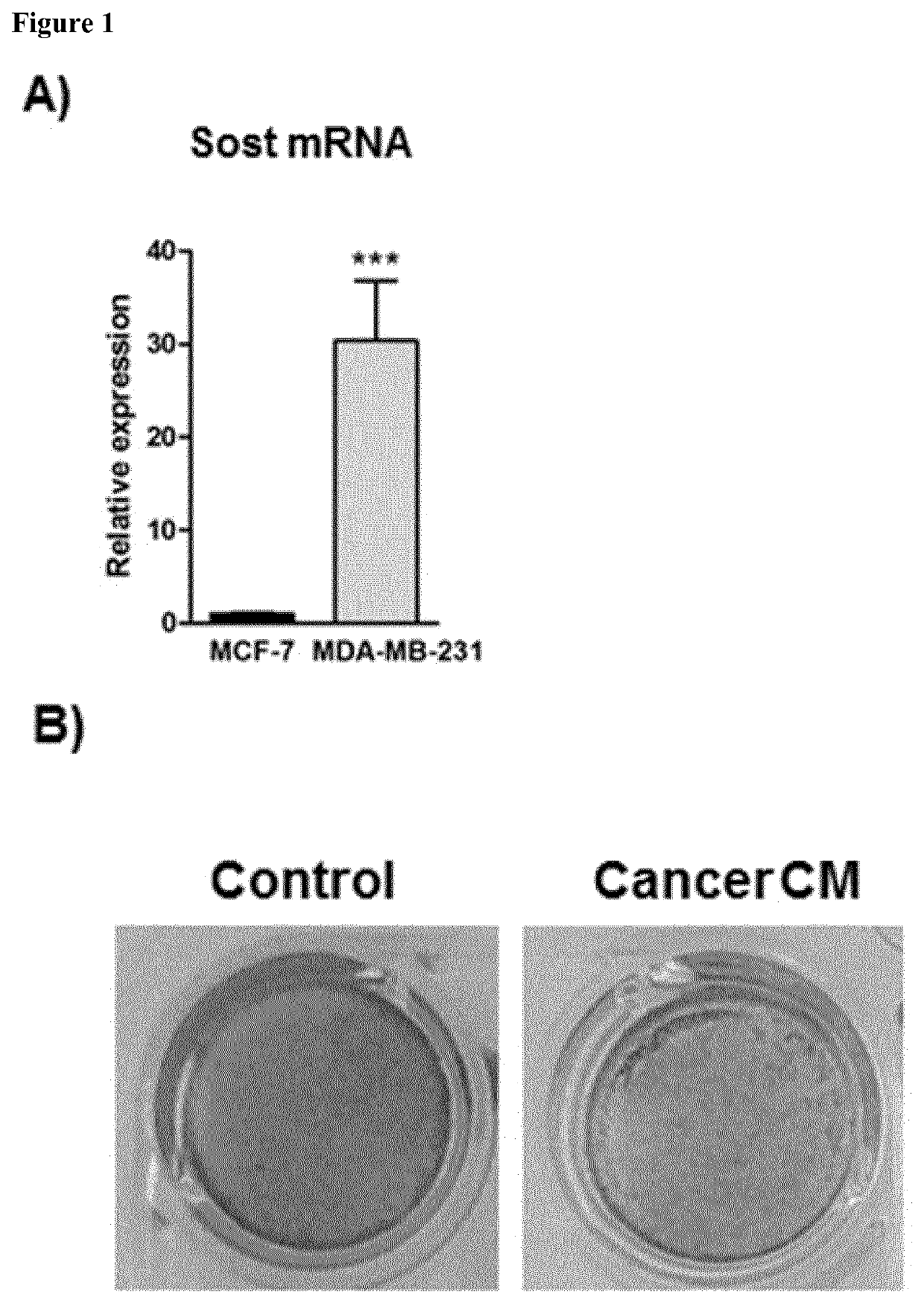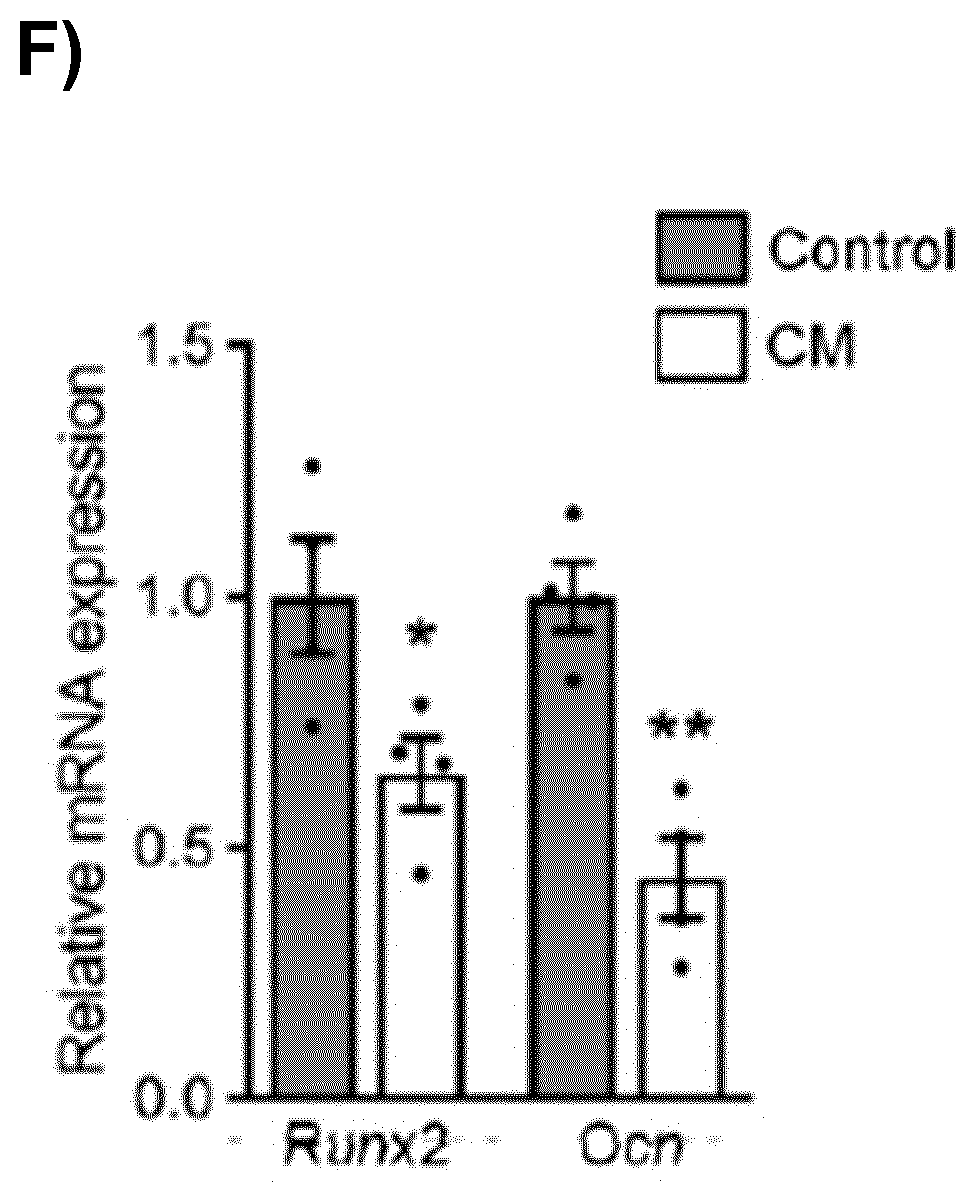Use of a sclerostin antagonist
a sclerostin antagonist and sclerostin technology, applied in the field of myopathy, can solve the problems of loss of skeletal muscle mass, size, strength and/or function, and achieve the effect of reducing or increasing the dose proportionally and facilitating administration
- Summary
- Abstract
- Description
- Claims
- Application Information
AI Technical Summary
Benefits of technology
Problems solved by technology
Method used
Image
Examples
example 2
n Expression is a General Feature of Breast Cancer Cells
[0116]Breast cancer cells have been shown to express Dickkopf 1 (Dkk1), a soluble antagonist of canonical Wnt signaling. However, antagonizing cancer cell-derived Dkk1 did not fully restore the activity of the Wnt pathway, suggesting that additional mechanisms might exist. Indeed, expression analysis revealed a significantly higher expression of the Wnt inhibitor sclerostin in metastatic MDA-MB-231 breast cancer cells compared to non-metastatic MCF-7 breast cancer cells (FIG. 1A). To determine whether sclerostin expression is a general feature of breast cancer cells, an in silico analysis was performed using the EMBL-EBI Expression. Atlas (Papatheodorou I et al. Nucleic Acids Rs. 2018;46(D1):D246-D251). In addition to cells of the MDA-MB-231 cell line, expression of sclerostin was found in cells of the SUM159PT, CAL51, HCC 1187, HCC 1197, HCC 1395, HCC 1806 and KPL-4 breast cancer cell lines. Interestingly, six of these cell li...
example 3
tions Conferring Resistance to Breast Cancer-Mediated Repression of Wnt Signaling
[0119]Sclerostin inhibits the activation of the canonical. Wnt signaling pathway in osteoblasts by binding to the first β-propeller domain of the extracellular region of the LRP5 receptor. Heterozygous missense mutations (G171V and A214V) within this domain of LRP5 cause a high bone mass phenotype in patients and in mice due to a reduced binding of sclerostin. To determine whether cancer cell-derived sclerostin inhibits Wnt activity in osteoblasts through Lrp5, the inventors obtained osteoblasts from genetically modified mice heterozygous for the Lrp5 mutation G171V. In support of our hypothesis, osteoblasts bearing a mutant Lrp5 with a disabled sclerostin binding site were resistant to breast cancer-mediated repression of Wnt signaling (FIG. 7). These data suggest that breast cancer cells impair osteoblast differentiation, at least in part, by a sclerostin / Lrp5-mediated inhibition of the canonical Wnt ...
example 4
n-Induced Bone Destruction and Effects of Scl-Ab Treatment
[0120]In addition, sclerostin inhibition prevented cancer-induced bone destruction determined by μCT and histological analyses (FIGS. 3A-C). Histological analyses of the proximal tibia revealed a significantly reduced bone formation rate and bone mass in cancer-bearing vehicle-treated mice compared to healthy vehicle-treated control animals (FIGS. 3L, D, E). Intriguingly, Scl-Ab treatment of mice with bone metastases not only restored bone mass comparable to the bone mass of healthy vehicle-treated control animals, but also increased both bone mass and bone formation to the level of healthy Scl-Ab-treated mice (FIGS. 3, D and E). Detailed histomorphometric analysis of the bone surfaces nearby metastases revealed that the presence of breast cancer cells blunted bone formation in vehicle-treated mice, which was significantly restored by Scl-Ab treatment (FIGS. 3, F and G). These results suggest that Scl-Ab prevents bone loss in...
PUM
| Property | Measurement | Unit |
|---|---|---|
| Fraction | aaaaa | aaaaa |
| Length | aaaaa | aaaaa |
| Mass | aaaaa | aaaaa |
Abstract
Description
Claims
Application Information
 Login to View More
Login to View More - R&D
- Intellectual Property
- Life Sciences
- Materials
- Tech Scout
- Unparalleled Data Quality
- Higher Quality Content
- 60% Fewer Hallucinations
Browse by: Latest US Patents, China's latest patents, Technical Efficacy Thesaurus, Application Domain, Technology Topic, Popular Technical Reports.
© 2025 PatSnap. All rights reserved.Legal|Privacy policy|Modern Slavery Act Transparency Statement|Sitemap|About US| Contact US: help@patsnap.com



